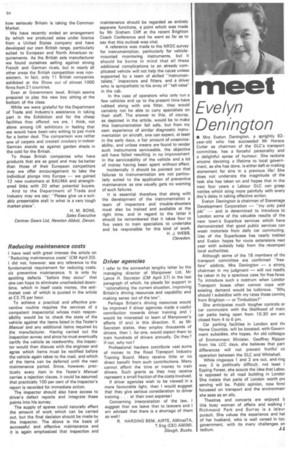Reducing maintenance costs
Page 66

If you've noticed an error in this article please click here to report it so we can fix it.
I have read with great interest the article on "Reducing maintenance costs" (CM April 20). I did not, however, see any reference to the fundamental requirement for reducing costs, viz preventive maintenance. It is only by spotting defects "before they occur" that one can hope to eliminate unscheduled downtime, which in itself costs money, the estimated cost of which is quoted in the article at £3.75 per hour.
To achieve a practical and effective preventive routine requires the services of a competent inspector(s) whose main responsibility would be to check the state of the vehicle against the items listed in the Tester's Manual and any additional items required by the manufacturer. Having carried out the inspection survey and since he must eventually certify the vehicle as roadworthy, the inspector would then discuss with the engineer and agree which items must be rectified before the vehicle again takes to the road, and which of the items can be deferred until the next maintenance period. Since, however, practically every item in the Tester's Manual carries a rejection clause, it could be assumed that practically 100 per cent of the inspector's report is recorded for immediate action.
The inspector should also have access to driver's defect reports and integrate these points into his survey.
The supply of spares could naturally affect the amount of work which can be carried out, but the final decision should be made by the inspector. The above is the basis of successful and effective maintenance and it is again emphasized that inspection and maintenance should be regarded as entirely separate functions, a point which was made by Mr Graham Cliff at the recent Brighton Coach Conference and he went so far as to say that this outlook was vital.
A reference was made to the NRDC survey for instrumentation, particularly for vehiclemounted monitoring instruments, but it should be borne in mind that all these additional complications to an already complicated vehicle will not help the cause unless supported by a team of skilled "instrumentalists," inspectors and fitters, and a driver who is sympathetic to his array of "tell-tales" in the cab.
In the case of operators who only run a few vehicles and up to the present time have rubbed along with one fitter, they would certainly not be able to carry specialists on their staff. The answer to this, of course, as depicted in the article, would be to make this instrumentation fail safe, but from my own experience of similar diagnostic instrumentation on aircraft, one can expect, at least in the early days. a fair amount of unserviceability, and unless means are found to render such instruments serviceable, the objective will have failed resulting in no improvement in the serviceability of the vehicle and a lot of money having been spent without effect.
Incidentally it should be pointed out that failures to instrumentation are not particularly suited to the application of preventive maintenance as one usually gets no warning of such failures.
It is essential therefore that along with the development of the instrumentation a team of inspectors and trouble-shooters must also be trained and available at the right time, and in regard to the latter it should be remembered that it takes four to five years to train specialists to undertake and be responsible for this kind of work. H. J. WEBB, Clevedon.
















































































































